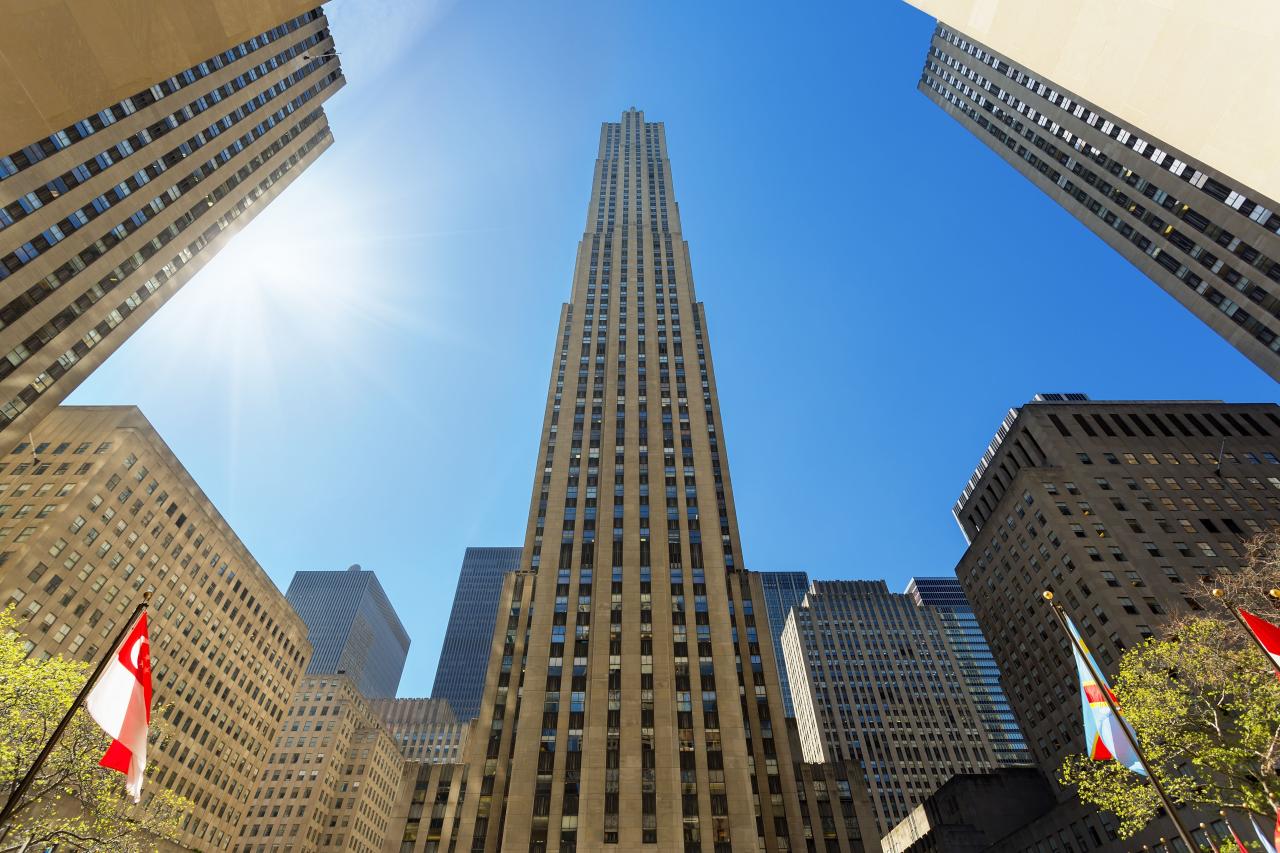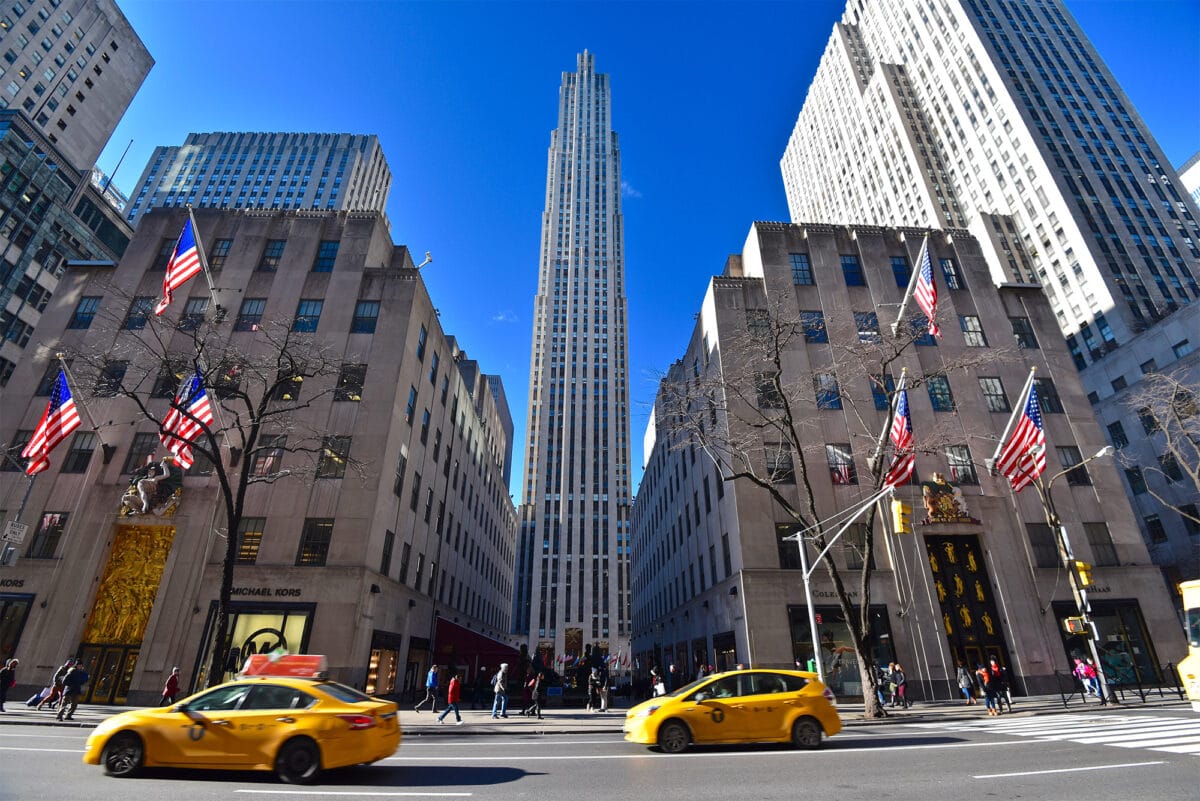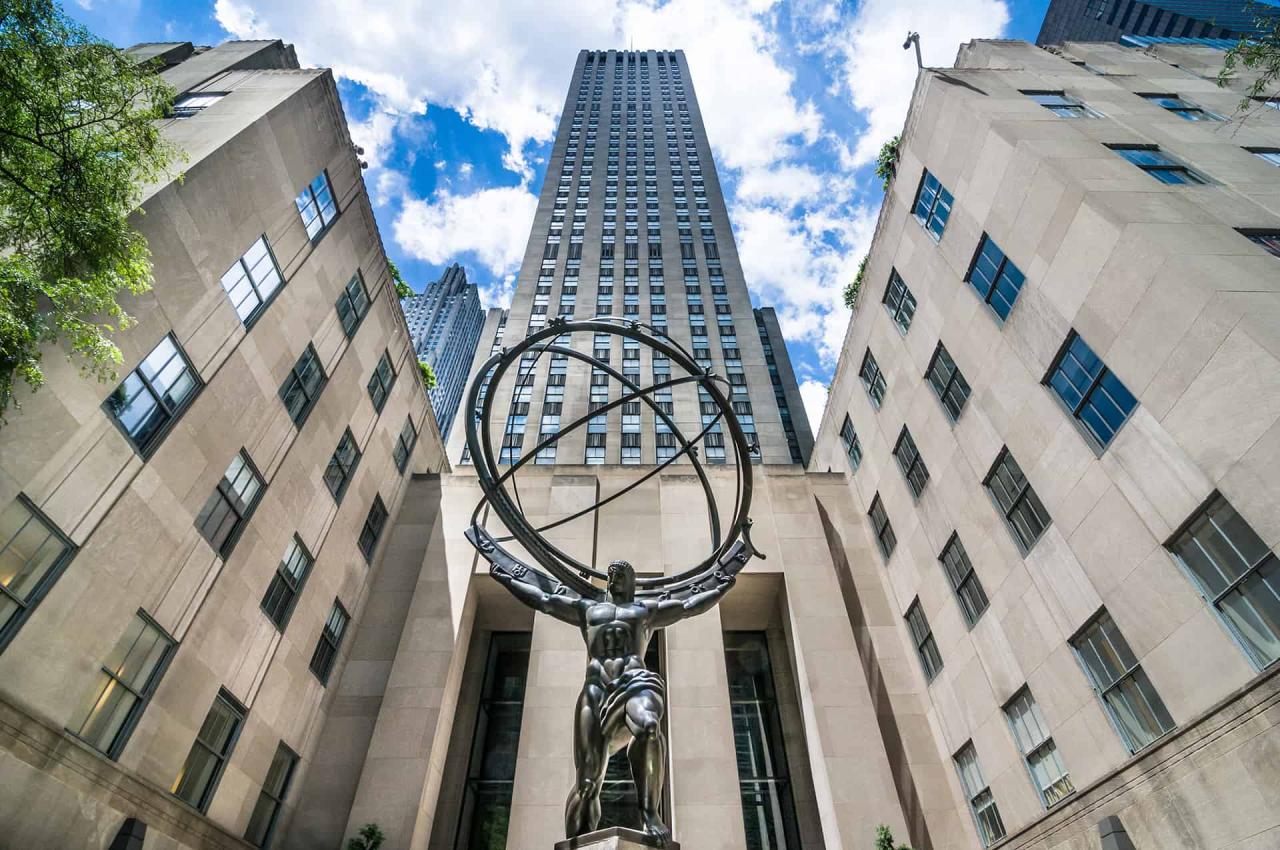Rockefeller Center, a legendary landmark in the heart of Manhattan, stands as a testament to architectural brilliance, cultural significance, and urban vitality. Its towering Art Deco structures, iconic public spaces, and renowned art installations have captivated visitors for generations.
From its inception by the Rockefeller family to its transformation into a thriving commercial and entertainment hub, Rockefeller Center’s story is one of innovation, ambition, and enduring legacy.
History and Significance
Rockefeller Center is a complex of 19 commercial buildings covering 22 acres (8.9 ha) between 48th and 51st Streets in Midtown Manhattan, New York City. Developed by the Rockefeller family, it is named after the family’s patriarch, John D. Rockefeller, Sr.
The center was designed by the architectural firm of Harrison & Abramovitz and constructed between 1930 and 1940.
The Rockefeller Center was built as part of the Rockefeller family’s plan to revitalize the area around St. Patrick’s Cathedral. The family purchased the land in the early 1920s and hired architect Raymond Hood to design the complex. Hood’s design was inspired by the City Beautiful movement and featured a mix of Art Deco and Beaux-Arts styles.
The center was designed to be a “city within a city,” with its own streets, parks, and shops.
The Rockefeller Family
The Rockefeller family was one of the wealthiest and most powerful families in the United States in the early 20th century. John D. Rockefeller, Sr. was the founder of Standard Oil, and his son, John D. Rockefeller, Jr., was a philanthropist and art collector.
The Rockefeller family played a major role in the development of New York City, and the Rockefeller Center was one of their most ambitious projects.
Impact on New York City
The Rockefeller Center had a major impact on New York City. It helped to revitalize the area around St. Patrick’s Cathedral and created a new center of commerce and culture in Midtown Manhattan. The center is also home to several of New York City’s most iconic landmarks, including the Empire State Building, the Rockefeller Center Christmas Tree, and the Radio City Music Hall.
Architectural Features
Rockefeller Center is renowned for its iconic Art Deco design, characterized by sleek lines, geometric forms, and intricate ornamentation. The complex comprises 19 buildings designed by a consortium of architects, including Raymond Hood, Wallace Harrison, and J. Andre Fouilhoux.The use of materials played a significant role in the architectural expression of Rockefeller Center.
Limestone, granite, and aluminum were extensively used to create a sense of solidity and grandeur. The buildings’ facades are adorned with bas-relief sculptures, friezes, and murals that depict scenes of American industry, commerce, and culture.
Materials and Symbolism
The exterior of the buildings features extensive use of limestone and granite, symbolizing strength and durability. Aluminum, a relatively new material at the time, was employed in the construction of the setbacks and spires, representing modernity and technological advancement.The interiors of the buildings are equally impressive, with marble, wood, and bronze used to create opulent and sophisticated spaces.
The grand lobby of 30 Rockefeller Plaza features a 12-foot-high bronze statue of Atlas holding the celestial sphere, symbolizing the strength and ambition of the Rockefeller family.
Public Spaces and Amenities
Rockefeller Center boasts extensive public spaces, transforming it into a vibrant hub for public gatherings, events, and tourism. The centerpiece of these spaces is the iconic Rockefeller Plaza, a 3-acre outdoor plaza that serves as a year-round destination for visitors.
Plazas and Gardens
The plaza is adorned with numerous sculptures, fountains, and seasonal displays, including the world-renowned Rockefeller Center Christmas Tree. It also hosts various events throughout the year, from concerts and markets to ice skating and movie screenings.Surrounding the plaza are several lush gardens, including the Channel Gardens and the British Empire Garden.
These green oases provide respite from the bustling city, offering serene settings for relaxation and contemplation.
Skating Rink
One of the most popular attractions in Rockefeller Center is the outdoor skating rink. During the winter months, the rink becomes a festive destination, attracting skaters of all ages. The rink is also used for special events, such as the annual Rockefeller Center Tree Lighting Ceremony.These public spaces are integral to the character and appeal of Rockefeller Center.
They foster a sense of community, provide opportunities for recreation and entertainment, and contribute to the overall vibrancy of the complex.
Art and Cultural Attractions
Rockefeller Center is not just a commercial hub but also a cultural destination with a diverse collection of art installations and cultural attractions. These works enhance the center’s aesthetic appeal and contribute to its overall cultural significance.The art at Rockefeller Center ranges from sculptures to murals to paintings, each with its unique artistic value and historical importance.
These works reflect the changing artistic trends and styles of the 20th and 21st centuries, showcasing the evolution of art and its role in public spaces.
Sculptures
One of the most iconic sculptures at Rockefeller Center is the Atlas statue, a bronze figure holding the celestial sphere on his shoulders. Created by Lee Lawrie, this sculpture represents strength and endurance and has become a symbol of the center.
Other notable sculptures include the Prometheus statue by Paul Manship, the Spirit of Transportation by Paul Manship, and the Wisdom and Knowledge statue by Gaston Lachaise.
Murals
The murals at Rockefeller Center depict various scenes and themes, including the history of New York City, the arts, and industry. The most famous mural is the “Arrival of Leif Ericson” by Reginald Marsh, which depicts the legendary Viking explorer arriving in North America.
Other notable murals include the “History of Aviation” by Edward Trumbull, the “Commerce and Industry” by Josep Maria Sert, and the “Man at the Crossroads” by Diego Rivera.
Paintings
The paintings at Rockefeller Center include works by renowned artists such as Henri Matisse, Pablo Picasso, and Marc Chagall. These paintings are displayed in various locations throughout the center, including the concourses, lobbies, and offices. The collection reflects the diversity of artistic styles and movements of the 20th century and provides a glimpse into the changing artistic landscape of the time.
Commercial and Retail: Rockefeller Center
Rockefeller Center is a prominent destination for shopping and dining, featuring a diverse array of retail and commercial offerings.
Since its inception, Rockefeller Center’s retail spaces have undergone a remarkable evolution. Initially designed as an upscale shopping destination, the center now houses a broader range of stores, including flagship locations of renowned brands, independent boutiques, and various dining options.
Flagship Stores
- Saks Fifth Avenue
- Banana Republic
- H&M
- Zara
- Uniqlo
Independent Boutiques
The center also supports local businesses and emerging designers through its curated selection of independent boutiques.
- Artists & Fleas
- Soho Home
- Brooklinen
- Diptyque
- Byredo
Dining Options
Rockefeller Center offers a wide range of dining experiences, from casual eateries to fine dining establishments.
- The Sea Grill
- Todd English Food Hall
- Shake Shack
- Starbucks
- Pret A Manger
Tourism and Entertainment
Rockefeller Center is a renowned tourist attraction in New York City, attracting millions of visitors annually. Its iconic landmarks and diverse offerings cater to a wide range of interests, making it a must-visit destination for both domestic and international travelers.
The center’s appeal lies in its unique blend of attractions, including the world-famous Christmas tree lighting ceremony, the Top of the Rock observation deck, and the ice skating rink. These experiences offer a festive and memorable atmosphere, capturing the essence of the city’s holiday spirit.
Christmas Tree Lighting Ceremony
The Rockefeller Center Christmas tree lighting ceremony is an annual tradition that draws immense crowds. The towering tree, adorned with thousands of twinkling lights, becomes the centerpiece of the festivities. The event features live music, celebrity performances, and a spectacular fireworks display, creating a magical ambiance that attracts visitors from far and wide.
Top of the Rock Observation Deck
The Top of the Rock observation deck offers breathtaking panoramic views of New York City from three different levels. Visitors can ascend to the 70th floor for an unobstructed view of Central Park, the Empire State Building, and the Hudson River.
The deck’s unique vantage point provides a memorable and awe-inspiring experience.
Ice Skating Rink
The Rockefeller Center ice skating rink is an iconic winter destination. Situated in the heart of the complex, the rink provides a festive atmosphere for skaters of all ages. Visitors can glide across the ice beneath the twinkling lights of the Christmas tree, creating lasting memories and capturing the spirit of the holiday season.
Sustainability and Environmental Initiatives
Rockefeller Center is committed to sustainability and environmental responsibility, implementing various initiatives to reduce its environmental impact and promote sustainability. These efforts align with the center’s mission to create a vibrant and sustainable urban environment.The center has earned LEED Gold certification for its environmental performance, demonstrating its dedication to green building practices.
Initiatives include:
Energy Efficiency
- Utilizing energy-efficient lighting systems, appliances, and HVAC equipment
- Implementing building automation systems to optimize energy usage
- Utilizing renewable energy sources, such as solar panels and wind turbines
Water Conservation, Rockefeller center
- Installing low-flow plumbing fixtures and water-efficient landscaping
- Implementing rainwater harvesting systems to collect and reuse rainwater
- Utilizing graywater systems to recycle wastewater for non-potable purposes
Waste Management
- Establishing comprehensive recycling and composting programs
- Reducing waste generation through responsible procurement and packaging practices
- Partnering with local waste management companies to ensure proper disposal and recycling
Green Transportation
- Promoting public transportation, walking, and biking through convenient access and amenities
- Providing electric vehicle charging stations and preferred parking for fuel-efficient vehicles
- Encouraging the use of alternative fuels and sustainable transportation options
Final Thoughts
Today, Rockefeller Center remains an enduring symbol of New York City’s cultural landscape. Its iconic silhouette, bustling plazas, and world-class attractions continue to enchant locals and tourists alike, making it a beloved destination for art, entertainment, and unforgettable experiences.
Questions Often Asked
What is the history behind Rockefeller Center?
Rockefeller Center was developed by the Rockefeller family in the 1930s as a commercial and cultural complex. It was designed to revitalize Midtown Manhattan during the Great Depression.
What are the architectural highlights of Rockefeller Center?
Rockefeller Center is renowned for its Art Deco architecture, featuring towering skyscrapers with setbacks, intricate facades, and iconic features such as the Atlas statue and the Prometheus Fountain.
What public spaces can be found at Rockefeller Center?
Rockefeller Center boasts extensive public spaces, including the sunken plaza with its ice skating rink, the Channel Gardens, and the Observation Deck at Top of the Rock.
What art installations are displayed at Rockefeller Center?
Rockefeller Center is home to a diverse collection of art installations, including murals, sculptures, and the iconic Christmas tree display.
What is the significance of Rockefeller Center for New York City?
Rockefeller Center is a major tourist attraction and a beloved destination for locals. It contributes to the city’s cultural and economic vitality, hosting events, exhibitions, and retail experiences.


